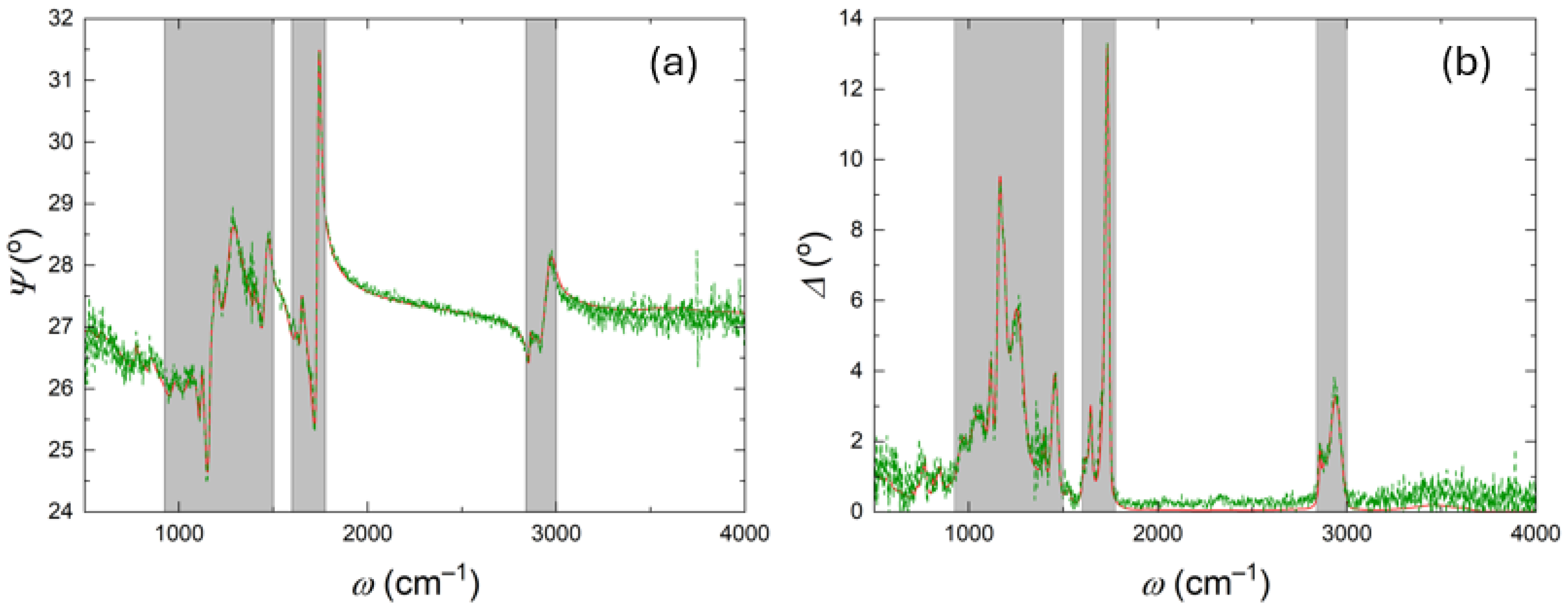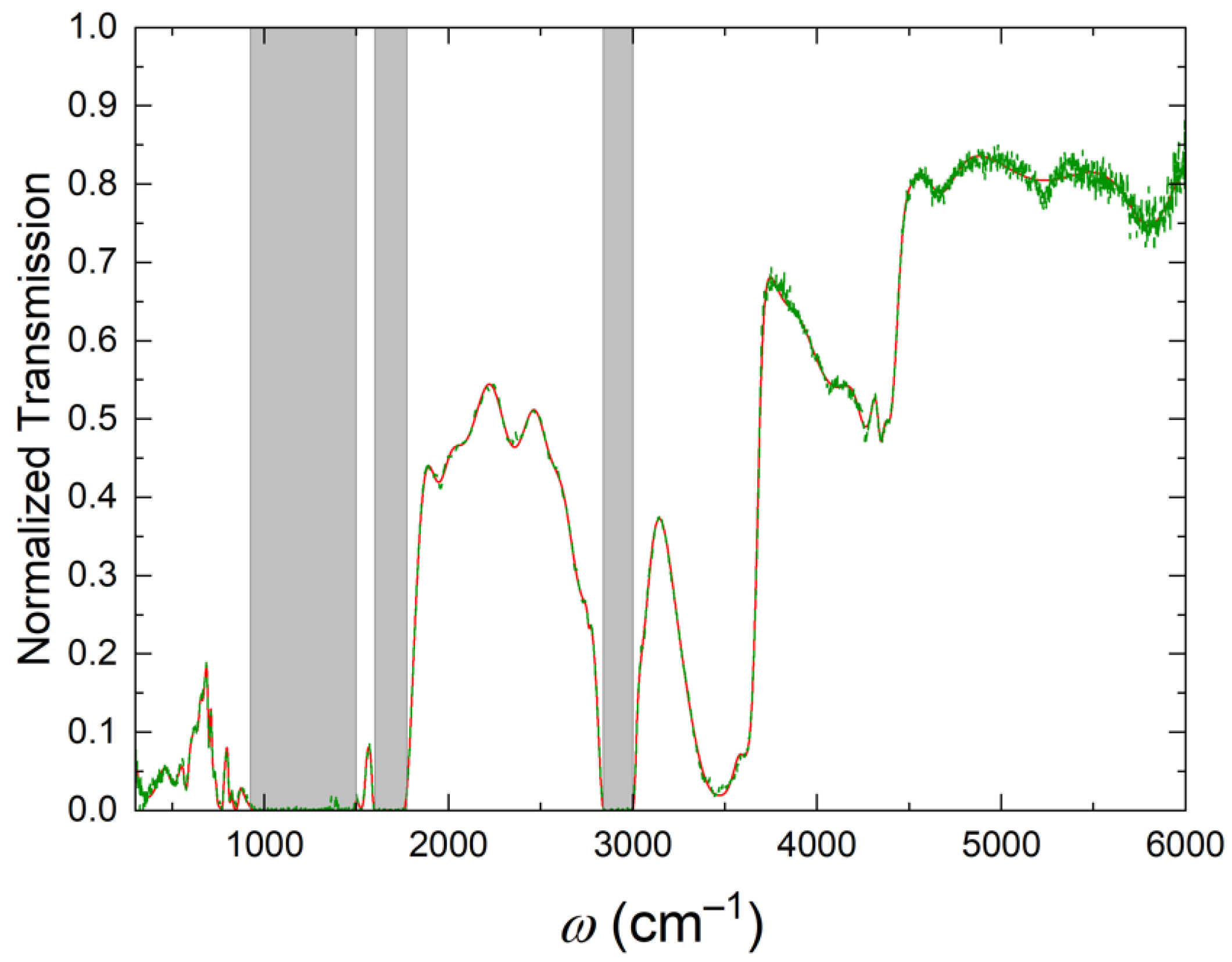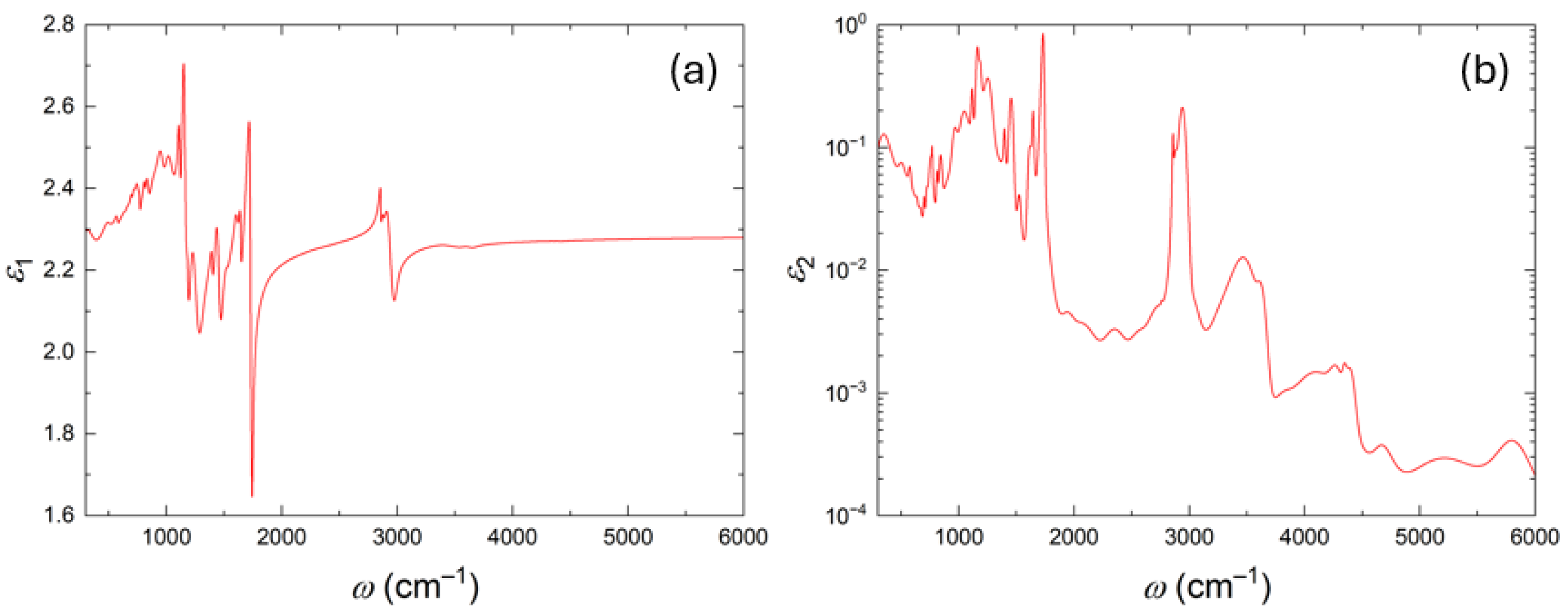Infrared Dielectric Function of Dragonfly Dielectric Ink 1092 Polymer from 300 cm−1 to 6000 cm−1
Abstract
1. Introduction
2. Materials and Methods
3. Results
4. Discussion
5. Summary and Conclusions
Author Contributions
Funding
Data Availability Statement
Acknowledgments
Conflicts of Interest
Appendix A
| Type | Amp | ||
|---|---|---|---|
| 1G | 340.03 ± 11.96 | 0.10727 ± 0.02926 | 139.84 ± 53.14 |
| 2G | 504.48 ± 8.27 | 0.01237 ± 0.01138 | 47.92 ± 39.98 |
| 3G | 507.24 ± 62.51 | 0.06016 ± 0.01843 | 264.76 ± 66.26 |
| 4G | 576.11 ± 2.52 | 0.01811 ± 0.00551 | 21.19 ± 6.43 |
| 5G | 637.47 ± 2.88 | 0.00428 ± 0.00166 | 19.12 ± 8.42 |
| 6G | 666.73 ± 2.65 | 0.00325 ± 0.00131 | 17.57 ± 9.31 |
| 7G | 700.01 ± 0.58 | 0.01255 ± 0.00169 | 10.98 ± 1.71 |
| 8G | 723.15 ± 1.58 | 0.01285 ± 0.00293 | 16.36 ± 3.85 |
| 9L | 755.95 ± 2.80 | 0.05950 ± 0.01311 | 37.64 ± 6.36 |
| 10L | 768.82 ± 1.79 | 0.04285 ± 0.01662 | 8.90 ± 6.22 |
| 11L | 813.07 ± 1.16 | 0.03009 ± 0.00612 | 13.40 ± 2.06 |
| 12G | 842.58 ± 1.35 | 0.04969 ± 0.00708 | 27.03 ± 3.10 |
| 13G | 965.25 ± 2.50 | 0.06055 ± 0.00562 | 43.88 ± 5.39 |
| 14G | 1044.20 ± 2.48 | 0.08258 ± 0.00727 | 72.25 ± 8.15 |
| 15G | 1115.50 ± 0.48 | 0.15462 ± 0.00996 | 17.06 ± 1.39 |
| 16G | 1151.40 ± 4.64 | 0.13068 ± 0.00980 | 437.25 ± 10.92 |
| 17G | 1162.50 ± 0.50 | 0.44053 ± 0.02041 | 25.08 ± 1.29 |
| 18G | 1186.80 ± 1.09 | 0.31790 ± 0.01516 | 29.05 ± 2.68 |
| 19G | 1253.80 ± 0.88 | 0.23990 ± 0.00867 | 69.25 ± 2.93 |
| 20L | 1397.00 ± 2.50 | 0.08515 ± 0.02091 | 18.67 ± 7.08 |
| 21G | 1454.70 ± 0.45 | 0.21272 ± 0.00520 | 35.50 ± 1.04 |
| 22G | 1525.50 ± 0.93 | 0.01964 ± 0.00186 | 29.43 ± 1.84 |
| 23G | 1615.30 ± 1.54 | 0.07076 ± 0.00581 | 32.24 ± 1.83 |
| 24L | 1644.90 ± 0.61 | 0.17228 ± 0.00889 | 18.77 ± 1.86 |
| 25L | 1714.20 ± 0.64 | 0.25766 ± 0.01386 | 34.78 ± 1.28 |
| 26G | 1731.40 ± 0.17 | 0.71991 ± 0.00848 | 20.63 ± 0.36 |
| 27G | 1942.20 ± 0.47 | 0.00128 ± 0.00007 | 104.94 ± 2.78 |
| 28G | 2078.40 ± 1.41 | 0.00283 ± 0.00002 | 274.20 ± 8.67 |
| 29G | 2360.00 ± 1.08 | 0.00268 ± 0.00003 | 214.34 ± 5.03 |
| 30G | 2564.10 ± 2.75 | 0.00223 ± 0.00008 | 170.72 ± 6.97 |
| 31G | 2718.90 ± 1.54 | 0.00329 ± 0.00010 | 158.23 ± 5.93 |
| 32G | 2761.40 ± 0.72 | 0.00033 ± 0.00004 | 13.90 ± 1.89 |
| 33L | 2857.80 ± 0.86 | 0.09671 ± 0.01226 | 12.17 ± 1.89 |
| 34G | 2880.10 ± 3.11 | 0.06936 ± 0.00798 | 39.27 ± 2.50 |
| 35G | 2940.00 ± 0.97 | 0.20264 ± 0.00438 | 63.80 ± 0.95 |
| 36L | 3034.90 ± 2.70 | 0.00432 ± 0.00018 | 144.59 ± 9.52 |
| 37G | 3334.50 ± 39.65 | 0.00492 ± 0.00111 | 288.71 ± 42.77 |
| 38G | 3486.00 ± 5.64 | 0.00995 ± 0.00188 | 208.69 ± 12.58 |
| 39G | 3626.20 ± 0.97 | 0.00422 ± 0.00022 | 76.79 ± 2.66 |
| 40G | 3791.80 ± 7.81 | 0.00037 ± 0.00004 | 172.35 ± 20.42 |
| 41G | 4099.60 ± 4.97 | 0.00140 ± 0.00001 | 492.75 ± 17.76 |
| 42G | 4277.70 ± 3.46 | 0.00060 ± 0.00003 | 112.95 ± 8.51 |
| 43G | 4345.20 ± 2.05 | 0.00094 ± 0.00004 | 36.58 ± 5.89 |
| 44L | 4396.30 ± 2.98 | 0.00042 ± 0.00009 | 81.51 ± 6.45 |
| 45G | 4677.00 ± 8.34 | 0.00094 ± 0.00004 | 250.41 ± 41.13 |
| 46G | 5195.90 ± 26.78 | 0.00027 ± 0.00002 | 627.03 ± 102.16 |
| 47G | 5809.10 ± 17.77 | 0.00038 ± 0.00003 | 407.05 ± 80.25 |
References
- Marasco, I.; Niro, G.; Rizzi, F.; D’Orazio, A.; De Vittorio, M.; Grande, M. Dual-band Flexible Planar Inverted-F Antenna for Internet of Healthcare Things Applications. In Proceedings of the Microwave Mediterranean Symposium (MMS), Pizzo Calabro, Italy, 9–13 May 2022. [Google Scholar] [CrossRef]
- Lv, X.; Yang, Y.; Luo, Z.; Tyo, J.S. Multimaterial 3-D-Printed FSSs for Ultrawide and Dual Passbands in the K–Ka Spectra. IEEE Trans. Microw. Theory Tech. 2024, 73, 75–86. [Google Scholar] [CrossRef]
- Samaitis, V.; Merfeldas, A.; Jankauskas, A.; Raišutis, R.; Jasiūnienė, E. From Print to Performance: A Comparative Study of Conductive and Radiated Emissions in FR-4 PCB Technology Versus DragonFly IV Additively Manufactured Electronics. ACS Appl. Electron. Mater. 2025, 7, 1381–1391. [Google Scholar] [CrossRef]
- Nguyen, M.D.; Yin, Z.; Del Rey, R.; Iacopi, F.; Yang, Y. Additive Manufacturing Materials and Processes for Passive Electronics in Wireless Communication. IEEE Trans. Mater. Electron Devices 2024, 1, 97–105. [Google Scholar] [CrossRef]
- Berglund, G.; Wisniowiecki, A.; Gawedzinski, J.; Applegate, B.; Tkaczyk, T.S. Additive manufacturing for the development of optical/photonic systems and components. Optica 2022, 9, 623–638. [Google Scholar] [CrossRef]
- Park, S.; Li, Y.; Norton, B.; McLamb, M.; Boreman, G.D.; Hofmann, T. One-Dimensional Photonic Crystals Fabricated Using Stereolithographic Single Layer Assembly for the Terahertz Spectral Range. J. Infrared Millim. Terahertz Waves 2020, 41, 542–551. [Google Scholar] [CrossRef]
- Fullager, D.B.; Park, S.; Hovis, C.; Li, Y.; Reese, J.; Sharma, E.; Lee, S.; Evans, C.; Boreman, G.D.; Hofmann, T. Metalized Poly-Methacrylate Off-Axis Parabolic Mirrors for Terahertz Imaging Fabricated by Additive Manufacturing. J. Infrared Millim. Terahertz Waves 2019, 40, 269–275. [Google Scholar] [CrossRef]
- Park, S.; Li, Y.; Fullager, D.B.; Schön, J.; Hofmann, T. Terahertz-Frequency Dielectric Anisotropy in Three-Dimensional Polymethacrylates Fabricated by Stereolithography. Opt. Lett. 2020, 45, 1982–1985. [Google Scholar] [CrossRef] [PubMed]
- Stinson, V.P.; Shuchi, N.; Louisos, D.; McLamb, M.; Boreman, G.D.; Hofmann, T. One-Dimensional Photonic Crystals with Mechanical Defects Fabricated by Two-Photon Polymerization. In Proceedings of the SPIE’s Optical Manipulation and Structured Materials Conference, Yokohama, Japan, 17–21 April 2023; SPIE: Bellingham, WA, USA, 2023; Volume 12606, p. 1260615. [Google Scholar] [CrossRef]
- Stinson, V.P.; Subash, U.; Poutous, M.K.; Hofmann, T. Towards Two-Photon Polymerization-Compatible Diffractive Optics for Micro-Mechanical Applications. Micromachines 2023, 14, 1319. [Google Scholar] [CrossRef] [PubMed]
- Li, Y.; McLamb, M.; Hofmann, T. Theoretical Study of Enhanced Plasmonic–Photonic Hybrid Cavity Modes in Reciprocal Plasmonic Metasurfaces. Plasmonics 2021, 16, 2241–2247. [Google Scholar] [CrossRef]
- Fullager, D.B.; Boreman, G.D.; Hofmann, T. Infrared dielectric response of Nanoscribe IP-Dip and IP-L monomers after polymerization from 250 cm−1 to 6000 cm−1. Opt. Mater. Express 2017, 7, 888–894. [Google Scholar] [CrossRef]
- Park, S.; Li, Y.; Fullager, D.B.; Schöche, S.; Herzinger, C.M.; Boreman, G.D.; Hofmann, T. Terahertz to Mid-infrared Dielectric Properties of Polymethacrylates for Stereolithographic Single Layer Assembly. J. Infrared Millim. Terahertz Waves 2019, 40, 971–979. [Google Scholar] [CrossRef]
- Fujiwara, H. Spectroscopic Ellipsometry: Principles and Applications; John Wiley & Sons: Chichester, UK, 2007. [Google Scholar] [CrossRef]
- Synowicki, R.; Tiwald, T.E. Optical properties of bulk c-ZrO2, c-MgO and a-As2S3 determined by variable angle spectroscopic ellipsometry. Thin Solid Films 2004, 455, 248–255. [Google Scholar] [CrossRef]
- Tompkins, H.; Irene, E.A. Handbook of Ellipsometry; William Andrew: Norwich, NY, USA, 2005. [Google Scholar]
- Meneses, D.S.; Malki, M.; Echegut, P. Structure and Lattice Dynamics of Binary Lead Silicate Glasses Investigated by Infrared Spectroscopy. J. Non-Cryst. Solids 2006, 352, 769–776. [Google Scholar] [CrossRef]
- Meneses, D.S.; Gruener, G.; Malki, M.; Echegut, P. Causal Voigt Profile for Modeling Reflectivity Spectra of Glasses. J. Non-Cryst. Solids 2005, 351, 124–129. [Google Scholar] [CrossRef]
- Peiponen, K.-E.; Vartiainen, E.M. Kramers–Kronig Relations in Optical Data Inversion. Phys. Rev. B 1991, 44, 8301–8303. [Google Scholar] [CrossRef] [PubMed]
- Press, W.H.; Flannery, B.P.; Teukolsky, S.A.; Vetterling, W.T. Numerical Recipes: The Art of Scientific Computing; Cambridge University Press: Cambridge, UK, 1988. [Google Scholar]
- Herzinger, C.M.; Snyder, P.G.; Johs, B.; Woollam, J.A. Ellipsometric determination of optical constants for silicon and thermally grown silicon dioxide via a multi-sample, multi-wavelength, multi-angle investigation. J. Appl. Phys. 1995, 77, 1715–1724. [Google Scholar] [CrossRef]
- Jellison, G.E. Spectroscopic ellipsometry data analysis: Measurement and analysis of optical functions of amorphous materials. Thin Solid Films 1998, 313–314, 33–39. [Google Scholar] [CrossRef]




Disclaimer/Publisher’s Note: The statements, opinions and data contained in all publications are solely those of the individual author(s) and contributor(s) and not of MDPI and/or the editor(s). MDPI and/or the editor(s) disclaim responsibility for any injury to people or property resulting from any ideas, methods, instructions or products referred to in the content. |
© 2025 by the authors. Licensee MDPI, Basel, Switzerland. This article is an open access article distributed under the terms and conditions of the Creative Commons Attribution (CC BY) license (https://creativecommons.org/licenses/by/4.0/).
Share and Cite
Louisos, D.; Engeland, J.; Shuchi, N.Z.; Gatley, S.I.; Federici, J.F.; Thomas, B.; Gatley, I.; Boreman, G.D.; Hofmann, T. Infrared Dielectric Function of Dragonfly Dielectric Ink 1092 Polymer from 300 cm−1 to 6000 cm−1. Optics 2025, 6, 59. https://doi.org/10.3390/opt6040059
Louisos D, Engeland J, Shuchi NZ, Gatley SI, Federici JF, Thomas B, Gatley I, Boreman GD, Hofmann T. Infrared Dielectric Function of Dragonfly Dielectric Ink 1092 Polymer from 300 cm−1 to 6000 cm−1. Optics. 2025; 6(4):59. https://doi.org/10.3390/opt6040059
Chicago/Turabian StyleLouisos, Dustin, Joseph Engeland, Nuren Z. Shuchi, Samuel I. Gatley, John F. Federici, Benjamin Thomas, Ian Gatley, Glenn D. Boreman, and Tino Hofmann. 2025. "Infrared Dielectric Function of Dragonfly Dielectric Ink 1092 Polymer from 300 cm−1 to 6000 cm−1" Optics 6, no. 4: 59. https://doi.org/10.3390/opt6040059
APA StyleLouisos, D., Engeland, J., Shuchi, N. Z., Gatley, S. I., Federici, J. F., Thomas, B., Gatley, I., Boreman, G. D., & Hofmann, T. (2025). Infrared Dielectric Function of Dragonfly Dielectric Ink 1092 Polymer from 300 cm−1 to 6000 cm−1. Optics, 6(4), 59. https://doi.org/10.3390/opt6040059






